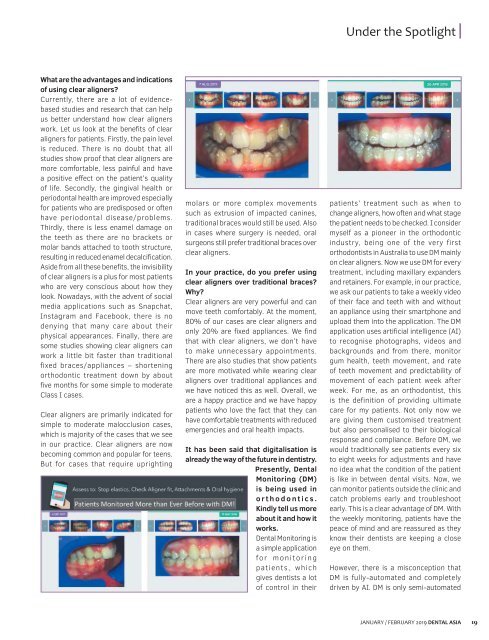Dental Asia January/February 2019
For more than two decades, Dental Asia is the premium journal in linking dental innovators and manufacturers to its rightful audience. We devote ourselves in showcasing the latest dental technology and share evidence-based clinical philosophies to serve as an educational platform to dental professionals. Our combined portfolio of print and digital media also allows us to reach a wider market and secure our position as the leading dental media in the Asia Pacific region while facilitating global interactions among our readers.
For more than two decades, Dental Asia is the premium journal in linking dental innovators
and manufacturers to its rightful audience. We devote ourselves in showcasing the latest dental technology and share evidence-based clinical philosophies to serve as an educational platform to dental professionals. Our combined portfolio of print and digital media also allows us to reach a wider market and secure our position as the leading dental media in the Asia Pacific region while facilitating global interactions among our readers.
Create successful ePaper yourself
Turn your PDF publications into a flip-book with our unique Google optimized e-Paper software.
Under the Spotlight<br />
What are the advantages and indications<br />
of using clear aligners?<br />
Currently, there are a lot of evidencebased<br />
studies and research that can help<br />
us better understand how clear aligners<br />
work. Let us look at the benefits of clear<br />
aligners for patients. Firstly, the pain level<br />
is reduced. There is no doubt that all<br />
studies show proof that clear aligners are<br />
more comfortable, less painful and have<br />
a positive effect on the patient’s quality<br />
of life. Secondly, the gingival health or<br />
periodontal health are improved especially<br />
for patients who are predisposed or often<br />
have periodontal disease/problems.<br />
Thirdly, there is less enamel damage on<br />
the teeth as there are no brackets or<br />
molar bands attached to tooth structure,<br />
resulting in reduced enamel decalcification.<br />
Aside from all these benefits, the invisibility<br />
of clear aligners is a plus for most patients<br />
who are very conscious about how they<br />
look. Nowadays, with the advent of social<br />
media applications such as Snapchat,<br />
Instagram and Facebook, there is no<br />
denying that many care about their<br />
physical appearances. Finally, there are<br />
some studies showing clear aligners can<br />
work a little bit faster than traditional<br />
fixed braces/appliances – shortening<br />
orthodontic treatment down by about<br />
five months for some simple to moderate<br />
Class I cases.<br />
Clear aligners are primarily indicated for<br />
simple to moderate malocclusion cases,<br />
which is majority of the cases that we see<br />
in our practice. Clear aligners are now<br />
becoming common and popular for teens.<br />
But for cases that require uprighting<br />
molars or more complex movements<br />
such as extrusion of impacted canines,<br />
traditional braces would still be used. Also<br />
in cases where surgery is needed, oral<br />
surgeons still prefer traditional braces over<br />
clear aligners.<br />
In your practice, do you prefer using<br />
clear aligners over traditional braces?<br />
Why?<br />
Clear aligners are very powerful and can<br />
move teeth comfortably. At the moment,<br />
80% of our cases are clear aligners and<br />
only 20% are fixed appliances. We find<br />
that with clear aligners, we don’t have<br />
to make unnecessary appointments.<br />
There are also studies that show patients<br />
are more motivated while wearing clear<br />
aligners over traditional appliances and<br />
we have noticed this as well. Overall, we<br />
are a happy practice and we have happy<br />
patients who love the fact that they can<br />
have comfortable treatments with reduced<br />
emergencies and oral health impacts.<br />
It has been said that digitalisation is<br />
already the way of the future in dentistry.<br />
Presently, <strong>Dental</strong><br />
Monitoring (DM)<br />
is being used in<br />
orthodontics.<br />
Kindly tell us more<br />
about it and how it<br />
works.<br />
<strong>Dental</strong> Monitoring is<br />
a simple application<br />
for monitoring<br />
patients, which<br />
gives dentists a lot<br />
of control in their<br />
patients’ treatment such as when to<br />
change aligners, how often and what stage<br />
the patient needs to be checked. I consider<br />
myself as a pioneer in the orthodontic<br />
industry, being one of the very first<br />
orthodontists in Australia to use DM mainly<br />
on clear aligners. Now we use DM for every<br />
treatment, including maxillary expanders<br />
and retainers. For example, in our practice,<br />
we ask our patients to take a weekly video<br />
of their face and teeth with and without<br />
an appliance using their smartphone and<br />
upload them into the application. The DM<br />
application uses artificial intelligence (AI)<br />
to recognise photographs, videos and<br />
backgrounds and from there, monitor<br />
gum health, teeth movement, and rate<br />
of teeth movement and predictability of<br />
movement of each patient week after<br />
week. For me, as an orthodontist, this<br />
is the definition of providing ultimate<br />
care for my patients. Not only now we<br />
are giving them customised treatment<br />
but also personalised to their biological<br />
response and compliance. Before DM, we<br />
would traditionally see patients every six<br />
to eight weeks for adjustments and have<br />
no idea what the condition of the patient<br />
is like in between dental visits. Now, we<br />
can monitor patients outside the clinic and<br />
catch problems early and troubleshoot<br />
early. This is a clear advantage of DM. With<br />
the weekly monitoring, patients have the<br />
peace of mind and are reassured as they<br />
know their dentists are keeping a close<br />
eye on them.<br />
However, there is a misconception that<br />
DM is fully-automated and completely<br />
driven by AI. DM is only semi-automated<br />
JANUARY / FEBRUARY <strong>2019</strong> DENTAL ASIA 19


















